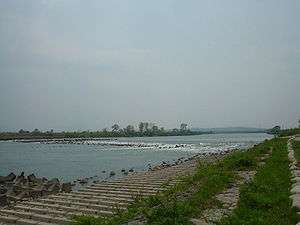Agano River
| Agano River 阿賀野川 | |
|---|---|
|
Agano River, 5/5/2007 | |
| Basin | |
| Main source | Mount Arakai, border of Fukushima Prefecture and Tochigi Prefecture |
| Source elevation | 1,581 m (5,187 ft) |
| River mouth | Sea of Japan, Niigata Prefecture |
| Mouth elevation | 0 m (0 ft) |
| Basin area | 7,710 km2 (2,980 sq mi) |
| Country | Japan |
| Length | 210 km (130 mi) |
| Avg. discharge | 451 m3/s (15,900 cu ft/s) |
It is called the Aga River or the Ōkawa River in Fukushima.
The source of the river is Mount Arakai on the border of Fukushima and Tochigi. It flows to the north and meets the Nippashi River from Lake Inawashiro and the Tadami River in the Aizu Basin, and then turns to the west and falls into the Sea of Japan. Its river mouth flow (451 m3/s, averaged from 1951 to 2002), is the largest of any river in Japan. The Agano River flows for 210 kilometers. It has a watershed area of 7,710 square kilometers.[1] Niigata plain is formed mostly by Agano river sediments.
Large tributaries of Agano River are Araki river, Aga River, Koagano River, Tadami River, Nippashi River (draining Lake Inawashiro).
In 1964-1965, a chemical factory at Kanose village in Niigata Prefecture released methylmercury into the river and caused Niigata Minamata disease. According to report of Japanese Ministry of the Environment in 2012, the mercury concentration in water is below 0.0005 mg/L, therefore river is considered safe.
The Agano River is feeding several notable hydroelectric power plants:
- Inawashiro Power Plant (107.5 MW), constructed several steps in 1899-1940. It was the site of the Japan first high-voltage, long-range power transmission line.
- Numazawanuma Power Plant (43.7 MW), constructed in 1952. It was the first pumped-storage power plant in Japan.
- 10 hydroelectric plants totaling 1.65 GW capacity are located on Tadami River
References
- ↑ "Agano River". Tourist Link. Retrieved 4 March 2013.
External links
37°57′48″N 139°07′46″E / 37.963224°N 139.129556°ECoordinates: 37°57′48″N 139°07′46″E / 37.963224°N 139.129556°E (mouth)
.jpg)

|
